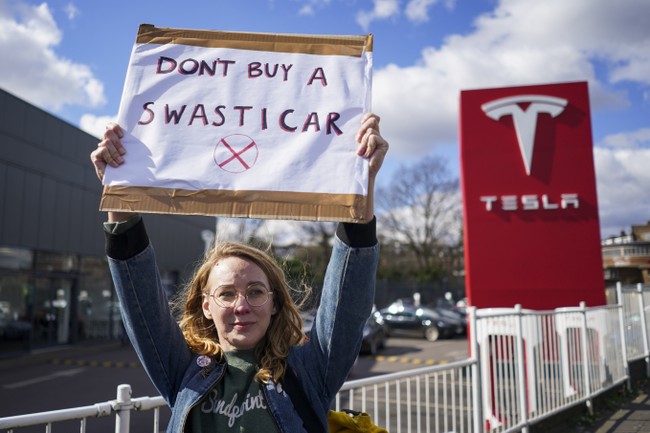
Contrary to what you might have heard, EV sales in the US were up in the first quarter according to two reports out recently from automotive research firms. First up, JD Power.
A J.D. Power report has revealed that the overall electric vehicle (EV) market share percentage rose to 9.3% in March 2025 compared to 8.4% during March 2024. While consumers are facing new and used car price increases stemming from President Trump’s tariffs on auto imports, 23% of shoppers looking for a new vehicle are “very likely” to consider purchasing or leasing an EV in the next 12 months, matching February’s percentage and up from 22.5% in March 2024.
As I wrote here, Tesla had a bad first quarter. That was partly thanks to its factories switching over to production of the refreshed Model Y, but primarily because of the full court press by Democrats to demonize Elon Musk, making him public enemy #1. That quickly turned into an effort to demonize Tesla to punish Musk which then also spilled over into protests, acts of vandalism and arson. By politicizing Tesla, the left has made people ashamed to own the cars and their efforts clearly are working with many like-minded voters. Meanwhile, partly thanks to that campaign against Tesla, other manufacturers had a banner quarter.
“We expect GM to be again the #2 seller electric vehicles in the U.S. with sales up 94% in the quarter,” GM reported on Tuesday, referring obliquely and somewhat snarkily to Tesla as the #1 EV seller…
“Cadillac retail sales were up 21%, with EVs up 37%,” GM also noted…
The Ford Motor Company also painted a rosy picture for EV sales in Q1, racking up a “record start” for hybrids (up 33%) and BEVs (up 12%).
“In the first quarter, Ford’s electrified vehicles represented 15% of total sales — up 3 percentage points over the same period last year,” Ford noted.
My guess is that absent the hate campaign aimed at Elon, many of the people who bought GM and Ford EVs this quarter would have bought Teslas. But because the left has made the brand radioactive people are simply moving to other options.
I’ve driven a few of these other cars including the VW ID4 and the Honda Prologue. They are improving but are still struggling to catch up to where Tesla was six years ago. The cars still can’t be updated remotely in the way Teslas can. They still don’t have the same power or efficiency. That said, if you’re moving from an older ICE car to a new ID4 or Honda Prologue it’s going to feel like a big improvement for a lot of people.
Going back to the big picture, Cox Automotive sees the same thing as JD Power. EV sales are up in the US, just not Tesla.
Sales of all-electric vehicles in the United States rose 11 percent during the first quarter to about 300,000 cars and light trucks, Cox said, much faster than the overall auto market, which has been flat. About 8 percent of new domestic car sales were electric, Cox said, a slight increase from 2024.
“Despite many obstacles — and what you may read elsewhere — electric vehicle sales continue to grow at a healthy pace in the U.S. market,” the firm said.
Tesla, whose chief executive is Elon Musk, still sells far more electric cars in the United States than any other automaker, accounting for 44 percent of the market, according to Cox. But its share has fallen from 51 percent a year earlier.
There was a very small decline in the percentage of shoppers who said they were “very likely” to consider an EV for their next car.
The total number of active new vehicle shoppers who say they are “very likely” to consider an EV for their next vehicle declined slightly to 23.0% in March 2025, down from 23.3% in February 2025 and up half a percentage point from 22.5% in March 2024.
Obviously 23% goes way beyond “early adopters.” It’s a significant percentage of buyers and one that will likely go up as the cost of EVs continues to decline. The slight decline in March is a trend worth watching, but with only about 9% of new sales being EVs at the moment and 23% of shoppers considering one for their next car, that suggests there’s plenty of room for sales to more than double. The market isn’t close to saturated in the US.
What has happened, in my view, is two things that are both heavily distorting the market at the moment. One, as mentioned already, Democrats have made the leading EV brand radioactive which turns potential buyers off to what is arguably the best EV out there. That’s helping GM, Ford, Honda and others catch up to Tesla, but it’s not helping the market overall. Democrats have essentially pushed the auto equivalent of identity politics which, as it always does, puts political considerations over merit.
Price is the other big factor that is still holding back a lot of buyers, but that problem has been solved. Unfortunately, it has been solved in China, the world’s largest car market has a thriving market for new, cheaper EVs. Those cheap Chinese EVs would sweep the US marketplace very quickly if we decided to drop the 100% tariffs (which were in place before this week’s tariff war) and let them in. For obvious reason, we don’t want to do that as it would a) damage domestic automakers and b) further fund the Chinese police state.
I’m glad we’re saying no to Chinese EVs but it is distorting the market. If there were a handful of $20,000 EVs for sale here, you’d see EV sales double (or more) within a year.
Tesla is supposedly working on a new, cheaper car which could be announced by June. That would potentially solve (or at least mitigate) the price problem but it would not solve the Elon-bad problem. So it’s hard to say how the US market will evolve from here but for now it’s still growing despite all the political headwinds.







